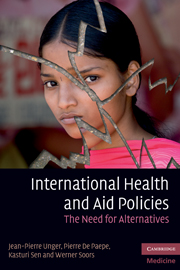Book contents
- Frontmatter
- Contents
- Preface
- Biographies
- Notices
- Acknowledgements
- List of abbreviations
- Reviews
- Introduction: Overview and purpose
- Section 1 Paradigms of international policies
- 1 Donor led policies: analysis of an underlying doctrine
- 2 The Achilles heel of international health policies in low- and middle-income countries
- Section 2 The failure of the aid paradigm: poor disease control in developing countries
- Section 3 Impact of international health policies on access to health in middle-income countries: some experiences from Latin America
- Section 4 Determinants and implications of new liberal health policies: the case of India, China and Lebanon
- Section 5 Principles for alternative, publicly oriented health care policies, planning, management and delivery
- Section 6 A public health, strategic toolkit to implement these alternatives
- Conclusions
- Glossary
- Index
- References
2 - The Achilles heel of international health policies in low- and middle-income countries
Published online by Cambridge University Press: 06 December 2010
- Frontmatter
- Contents
- Preface
- Biographies
- Notices
- Acknowledgements
- List of abbreviations
- Reviews
- Introduction: Overview and purpose
- Section 1 Paradigms of international policies
- 1 Donor led policies: analysis of an underlying doctrine
- 2 The Achilles heel of international health policies in low- and middle-income countries
- Section 2 The failure of the aid paradigm: poor disease control in developing countries
- Section 3 Impact of international health policies on access to health in middle-income countries: some experiences from Latin America
- Section 4 Determinants and implications of new liberal health policies: the case of India, China and Lebanon
- Section 5 Principles for alternative, publicly oriented health care policies, planning, management and delivery
- Section 6 A public health, strategic toolkit to implement these alternatives
- Conclusions
- Glossary
- Index
- References
Summary
Chapter 2 contains material previously published in:
Unger J.-P., De Paepe P., Ghilbert P., Soors W., Green A. 1. Disintegrated care: the Achilles heel of international health policies in low and middle-income countries. International Journal of Integrated Care 2006; 6. ISSN 1568–4156.
Introduction
It is clear to many health practitioners throughout the world, and, more recently, to WHO, that disease control, the favoured model of international aid, has failed to produce many of the desired results in LMICs despite intensive financing and political support. Following an insight of the related evidence, we will examine why international aid policies in our view share a large responsibility for this failure, with their promotion of the commodification of care, privatization of services, and a focus on disease control.
The poor performance of disease-control programmes (an update)
International health and aid policies have been highly restrictive because they ruled out as a priority access to family medicine and general hospital care. Furthermore, the definition of their priorities is questionable. The promotion of disease-specific programmes has been based on the concept of the ‘burden of disease,’ which functioned as the intellectual rationale for policies being implemented in its name. Its intrinsic logic was flawed (see Section 5, Chapter 12), and it was never used as a practical tool. Consequently, the international coalition (established on the basis of working on the ‘disease burden’) has largely managed to evade the need for scientifically based definitions of priorities (Bossyns, 1997; Shiffman et al., 2002; Shiffman, 2006; Sridhar & Batniji, 2008).
Acute respiratory infection (ARI) represented 25% of the world's ‘burden of disease’ but receives funds corresponding to 3% of total health-related overseas development aid;
[…]
- Type
- Chapter
- Information
- International Health and Aid PoliciesThe Need for Alternatives, pp. 16 - 34Publisher: Cambridge University PressPrint publication year: 2010



